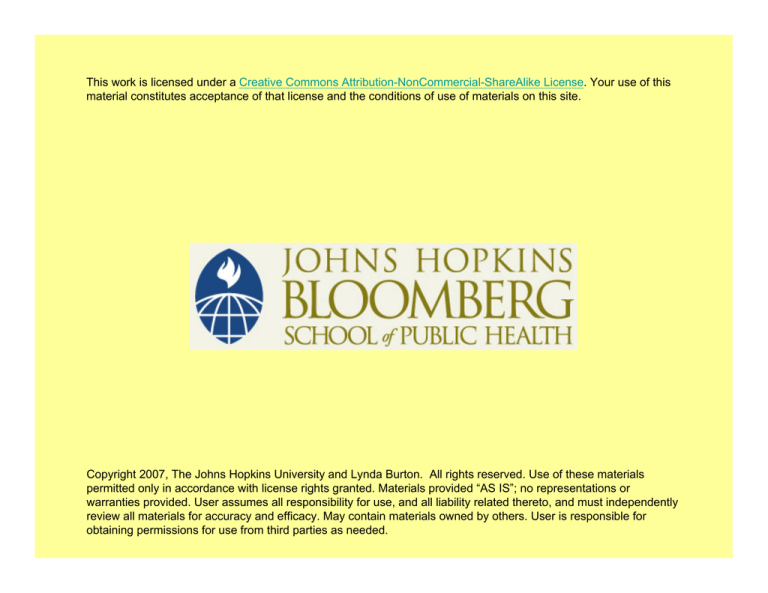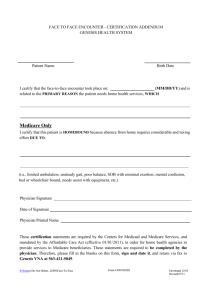
This work is licensed under a Creative Commons Attribution-NonCommercial-ShareAlike License. Your use of this
material constitutes acceptance of that license and the conditions of use of materials on this site.
Copyright 2007, The Johns Hopkins University and Lynda Burton. All rights reserved. Use of these materials
permitted only in accordance with license rights granted. Materials provided “AS IS”; no representations or
warranties provided. User assumes all responsibility for use, and all liability related thereto, and must independently
review all materials for accuracy and efficacy. May contain materials owned by others. User is responsible for
obtaining permissions for use from third parties as needed.
Federal Health Care Issues
Related to Older Persons
Lynda Burton
Lecture Outline
• Share of Nation’s health dollars for older
persons (c. 33%)
• Where expenditures go
• Medicare reimbursement: PPS
• Managed care vs. Fee for Service
• MMA, 2003
–
–
–
–
Prescription drugs
Chronic care improvement
Pay for performance
Information technology
Medicare, Medicaid, and SCHIP account for onethird of national health spending.
Medicaid and
SCHIP
15%
Other Public
12%
1
All CMS
Programs
33%
Other Private
6%
CY 2000
2
Private Insurance
34%
Medicare
17%
Out-of-pocket
15%
Total National Health Spending = $1.3 Trillion
1 Other public includes programs such as workers’ compensation, public health activity, Department of Defense, Department of
Veterans Affairs, Indian Health Service, and State and local hospital subsidies and school health.
2 Other private includes industrial in-plant, privately funded construction, and non-patient revenues, including philanthropy.
Note: Numbers shown may not sum due to rounding.
Source: CMS, Office of the Actuary, National Health Statistics Group.
Where the Medicare Dollar Went: 1980 and 2005
Medicare spending has moved from inpatient hospital services to all other settings. Managed
care has grown while the physician share declined.
1980
HHA
2%
Physician
2005
Administrative
2% Expenses
Outpatient Hospital
5% and Other
Outpatient Facility1
14%
Other
24%
Inpatient
Hospital
43%
14%
Managed Care
SNF
1%
Inpatient Hospital
68%
17%
Physician
Total = $37 Billion
1 Other services include other professional services and ambulance services.
Note: Data do not sum due to rounding. Spending includes benefit dollars only.
Source: CMS, Office of the Actuary, Trustees Report 2006
Home4%
Health
Care
6%
SNF
Total = $336 Billion
Issue: Federal Funds Provided to States for Medicaid
Over twenty-two percent of state total spending and over forty-four percent of federal
funds provided to states were spent on Medicaid.
Total State Spending
Elementary &
Secondary
Education
21.4%
Federal Funds Provided to States
Elementary &
Secondary
Education
11.4%
Higher
Education
10.9%
Public
Assistance
2.1%
Higher
Public
Education
Assistance
5.6%
3.6%
Transportation
8.0%
Corrections
0.6%
Transportation
8.0%
Medicaid
22.3%
Corrections
3.5%
All Other
26.3%
Medicaid
44.5%
All Other
31.7%
Source: National Association of State Budget Officers, 2004 State Expenditure Report.
Definition of Prospective Payment Systems
• A Prospective Payment System (PPS) is a method of
reimbursement in which Medicare payment is made
based on a predetermined, fixed amount.
• The payment amount for a particular service is derived
based on the classification system of that service (for
example, DRGs for inpatient hospital services).
• CMS uses separate PPSs for reimbursement to acute
inpatient hospitals, home health agencies, hospice,
hospital outpatient, inpatient psychiatric facilities,
inpatient rehabilitation facilities, long-term care hospitals,
and skilled nursing facilities.
From CMS website
Issue: Medicare reimbursement policies
– Physician payments
• RBRVS
– Hospital
• PPS (DRGs) 1983
– Skilled nursing home
• PPS 1999
– Home health
• PPS 2000
– Hospice
• FFS , per visit or service
Issue: Hospital payments
• DRGs
– Effect on length of stay
– Rise in sub-acute care, skilled nursing care
• Maryland’s unique all-payer system
• Pay for Performance (P4P) based on
quality indicators
Issue: Physician payment
• Physician payment: 17% of Medicare
costs in 2005
• Physician fee schedule
– Relative value units
– Has it worked? MEDPAC
• Revenue from Medicare c. 20%
RBRVS (Relative value units)
• Attempt to control rise in cost of
procedures and stagnation in payments for
non-procedural events
– amount of work required to provide a service
– expenses related to maintaining a practice
– liability insurance costs
Issue: Managed care vs. fee for service
• 20% of Medicare beneficiaries in MA plans
• Advantages and disadvantages
– Integrated care
– Risk as incentive to HMO to prevent disease
– Payment for HMOs
• CMS adjustments (claims-based risk adj)
• Overpayment for MAs?
– Medicare private fee-for-service plans
Issue: Out-of-Pocket Expenses for Medicare Beneficiaries
Beneficiaries without supplemental insurance and those with Medigap coverage have higher outof-pocket spending than other groups.
$5,000
$4,673
$4,324
$4,500
$3,950
P er C apita D ollars
$4,000
$3,957
$3,500
$2,776
$3,000
$2,977
$2,500
$2,000
$1,500
$1,000
$500
$0
Medicare FFS
Only
Medigap
Other
Employer
Sponsored
Plan
Medicaid
Medicare Risk
HMO
. by Type of Insurance Coverage, 2003 Note: Premium payments are included
Source: CMS, Office of Research, Development, and Information: Data from the Medicare Current Beneficiary Survey (MCBS), 1993
and 2003 Cost and Use Files.
Other issues: MMA 2003
•
•
•
•
Prescription drugs
Chronic care improvement
Linking quality with performance
Information technology
Pay for Performance (P4P)
• Payment linked to whether quality
indicators were achieved
• Who defines quality?
• CMS demonstrations in hospital care,
physician providers
– HaH Health Care Quality Demonstration
Waiver





